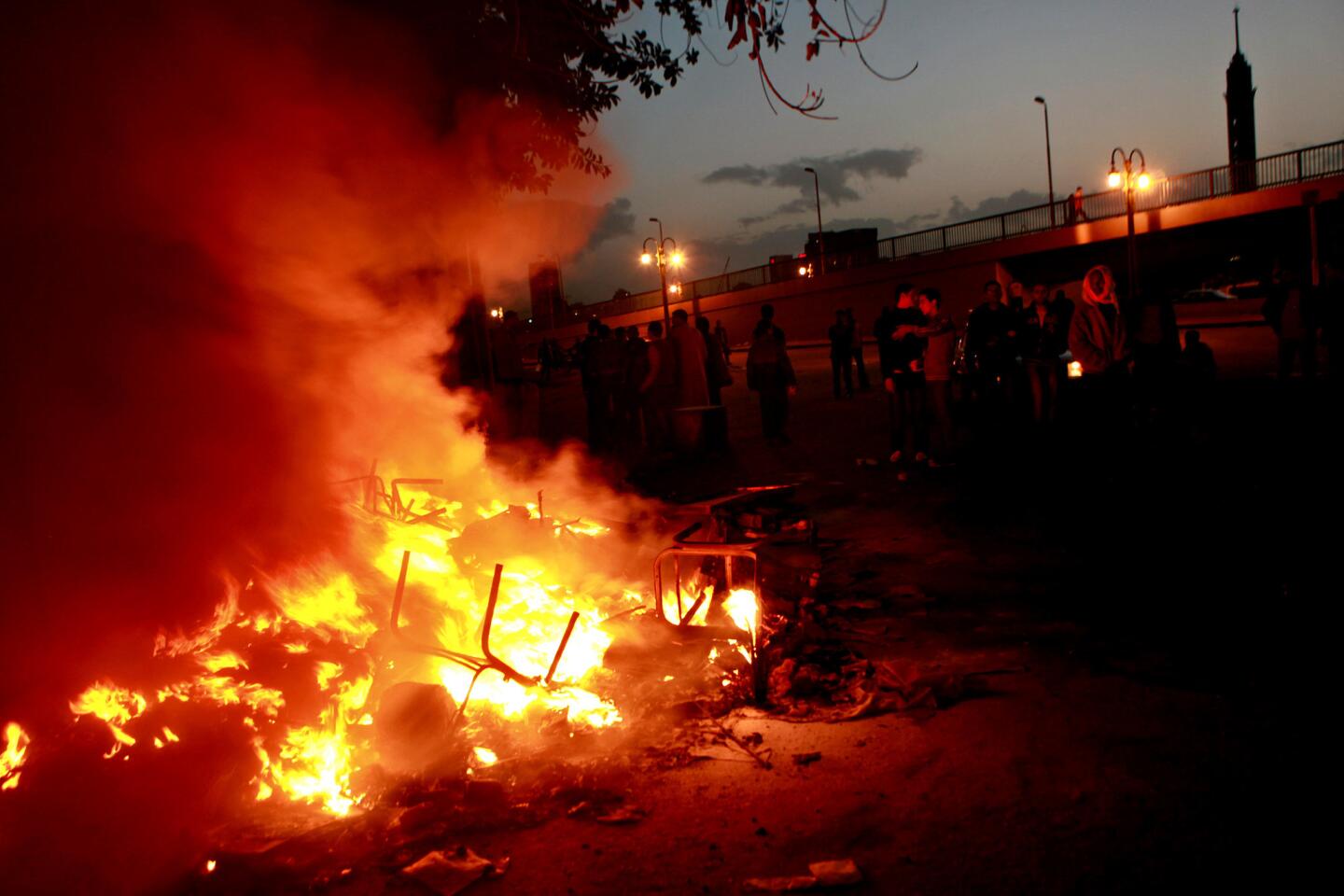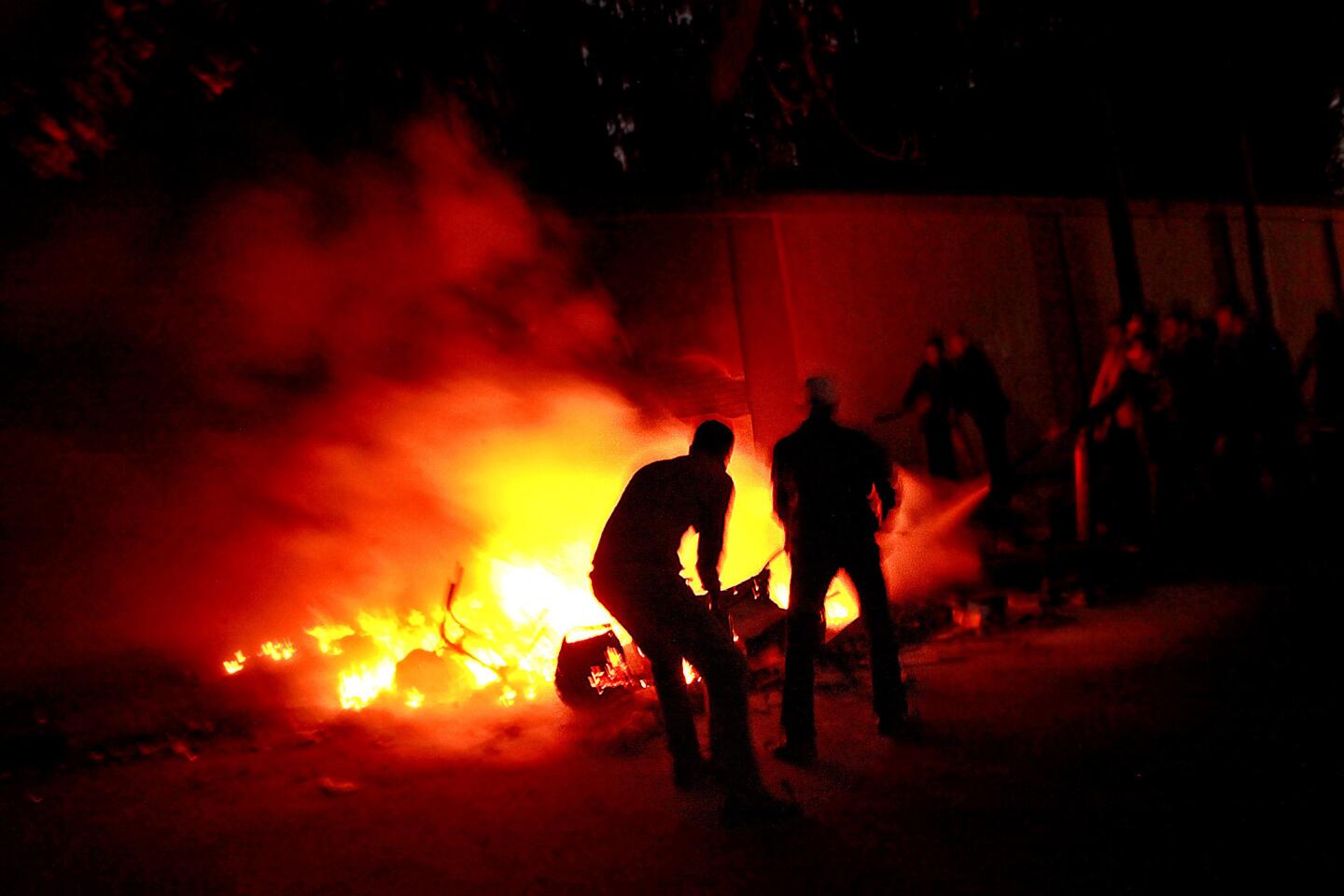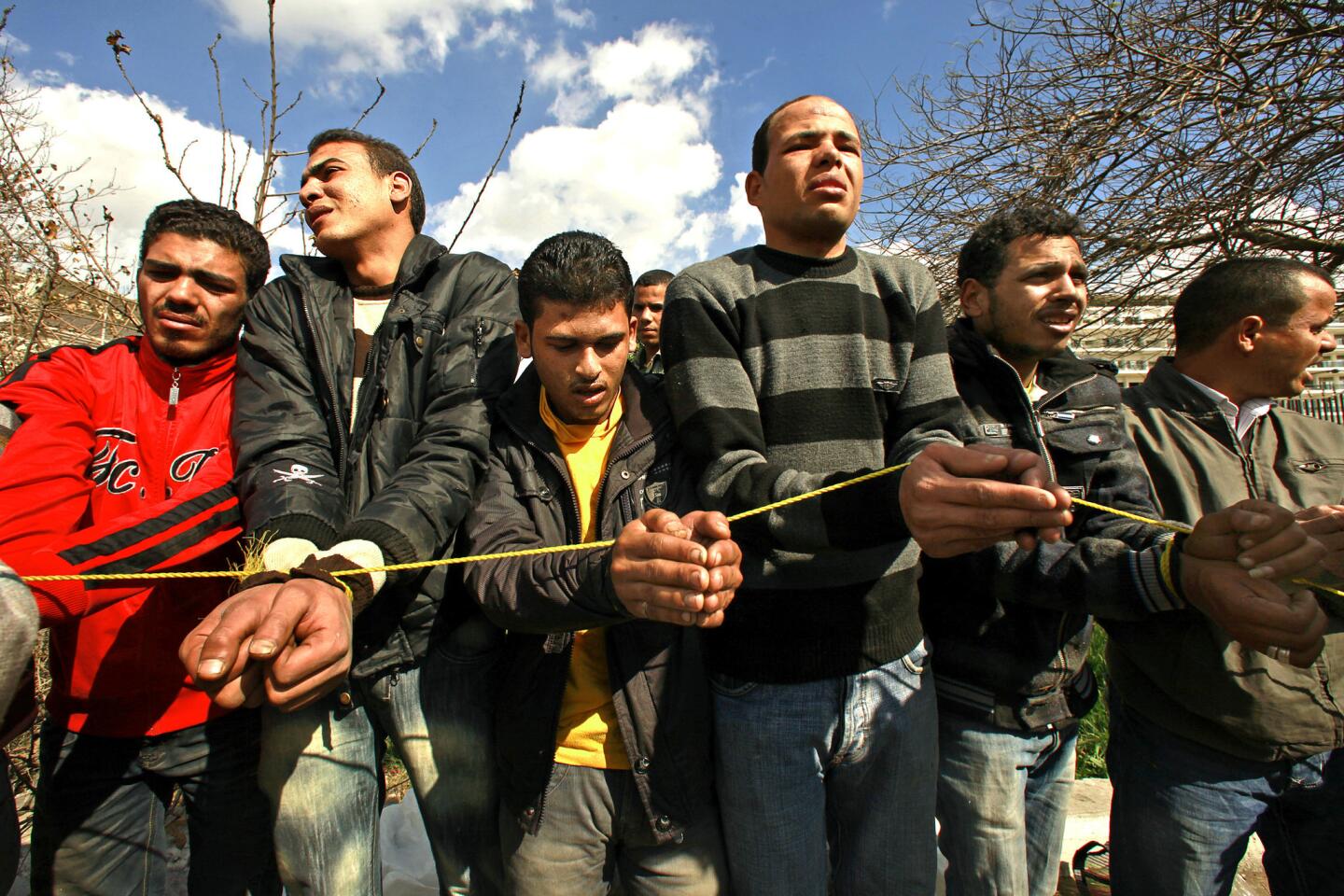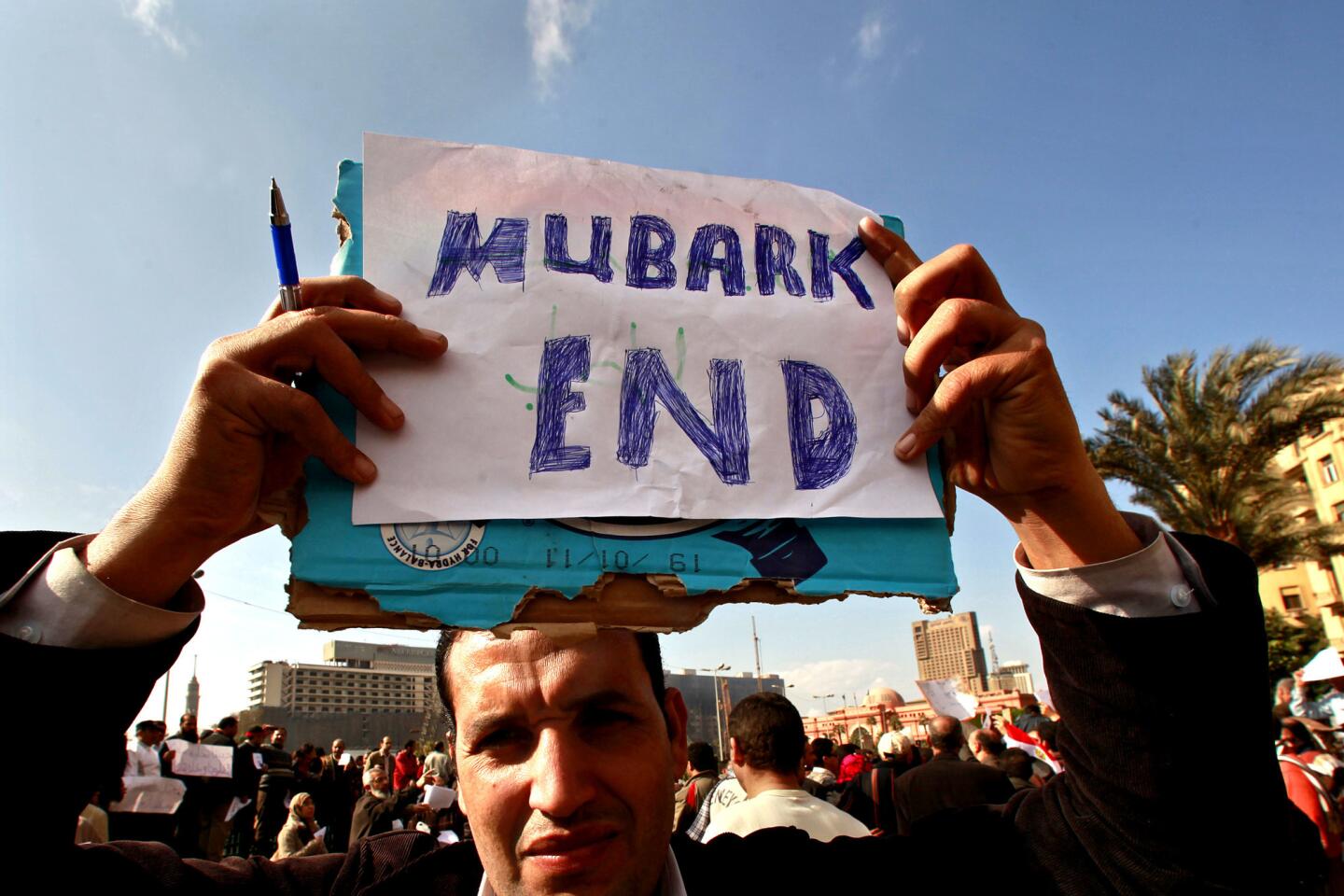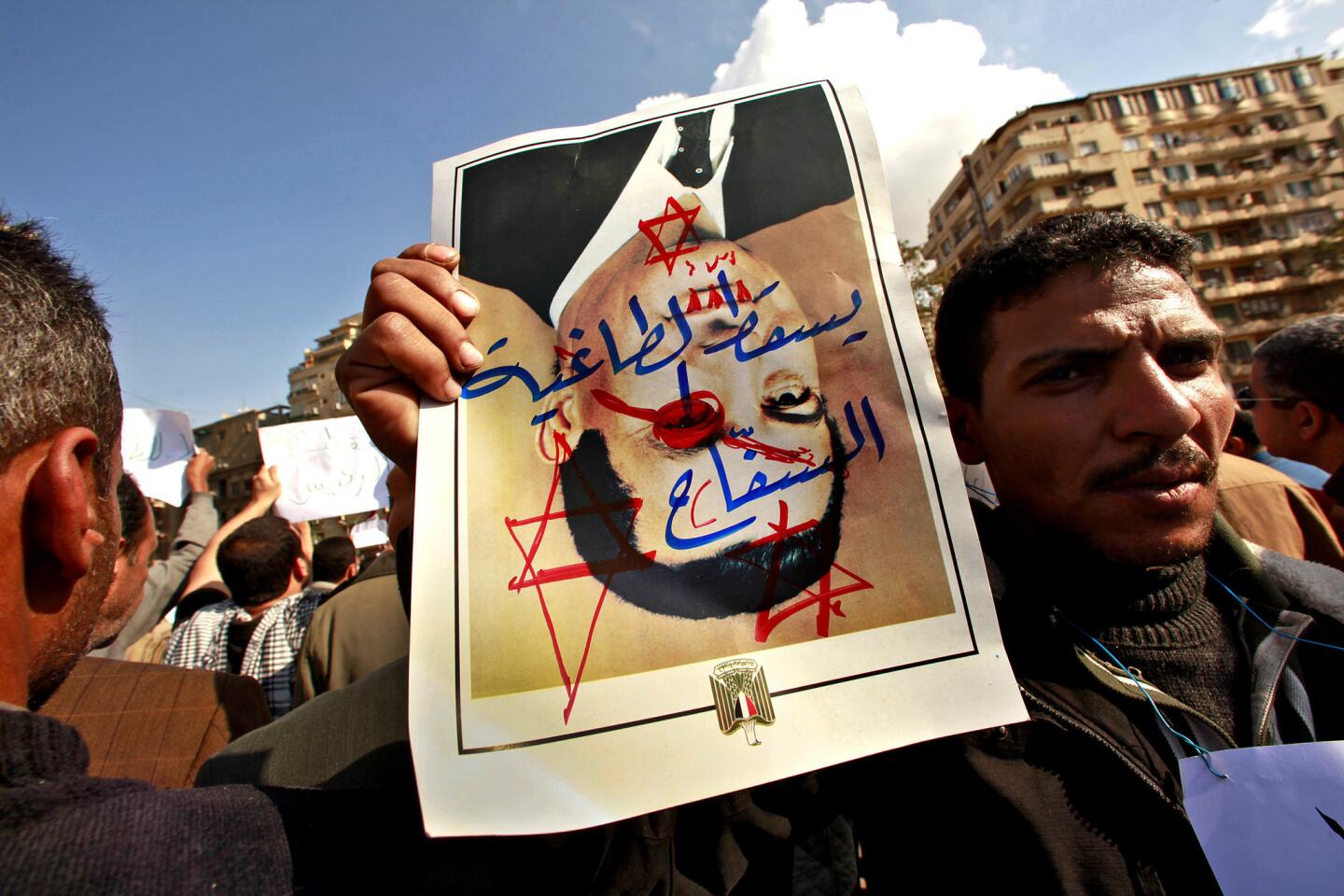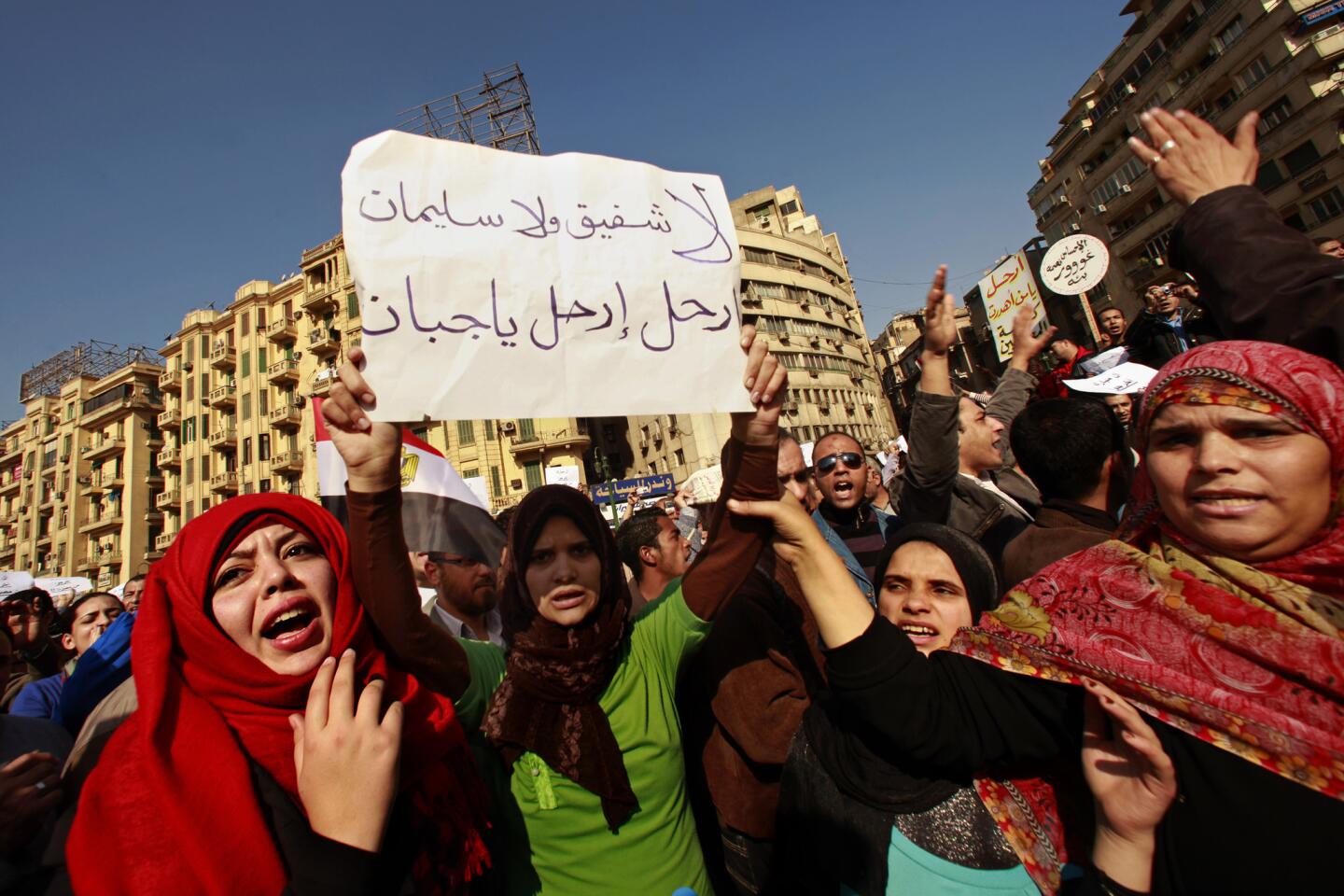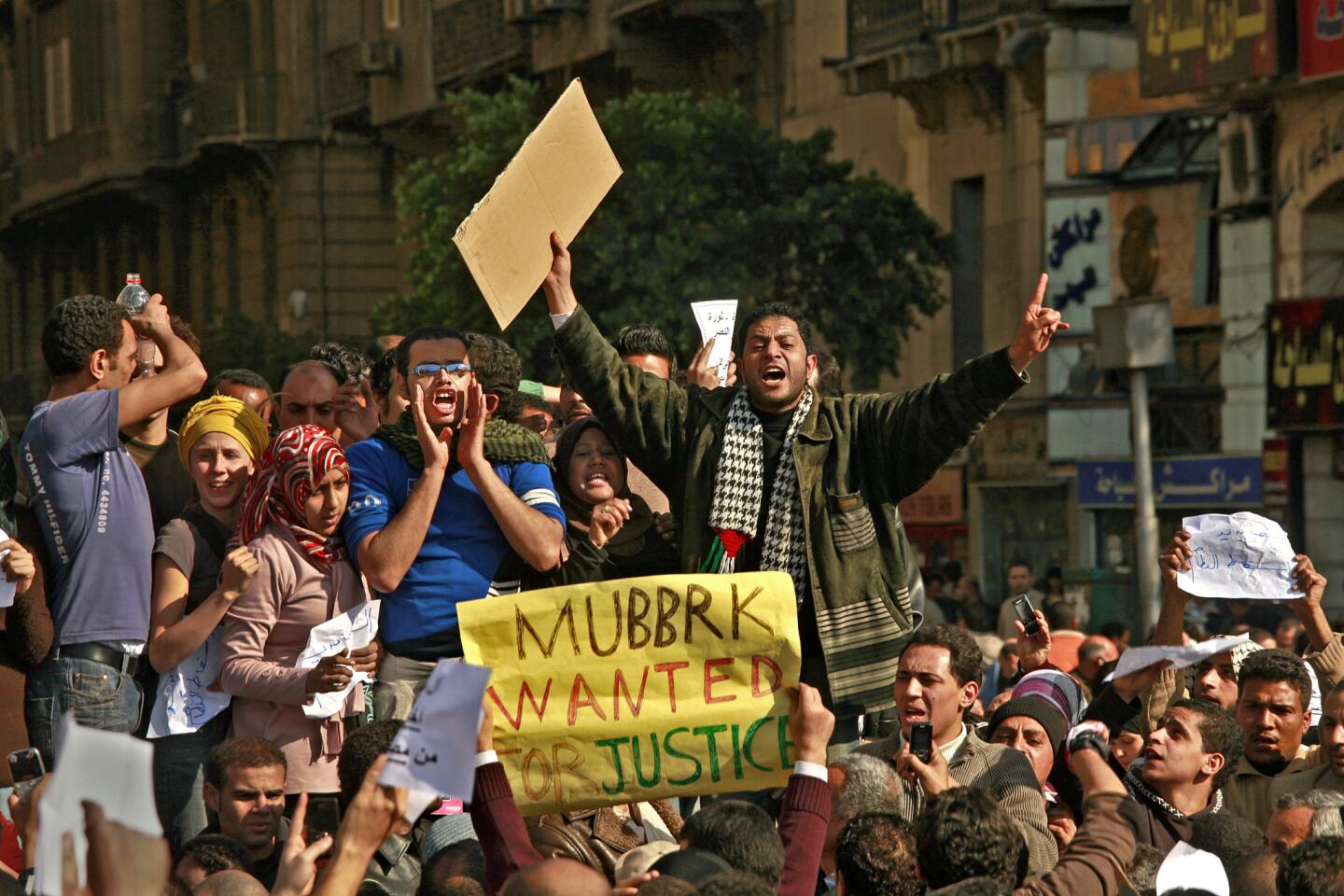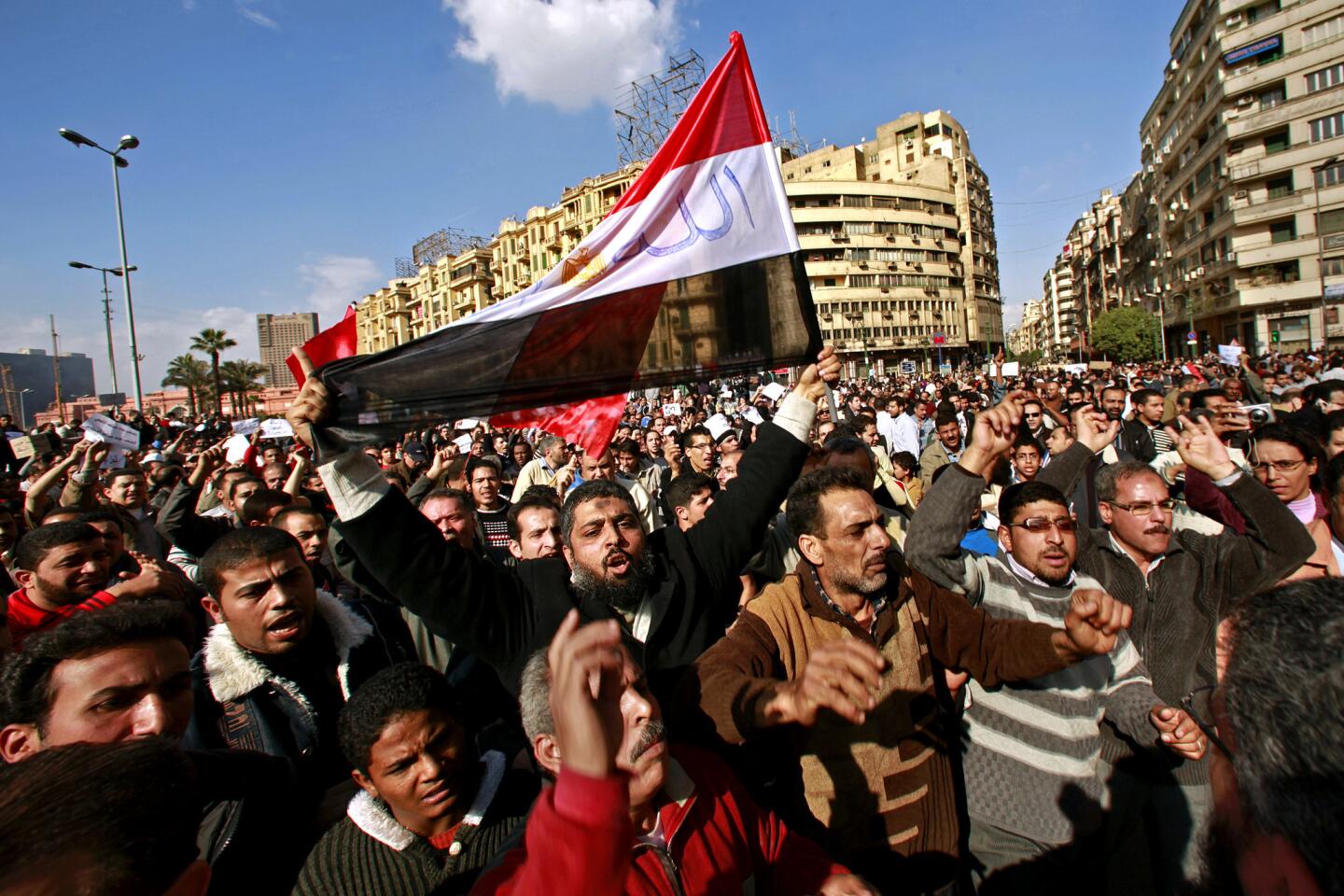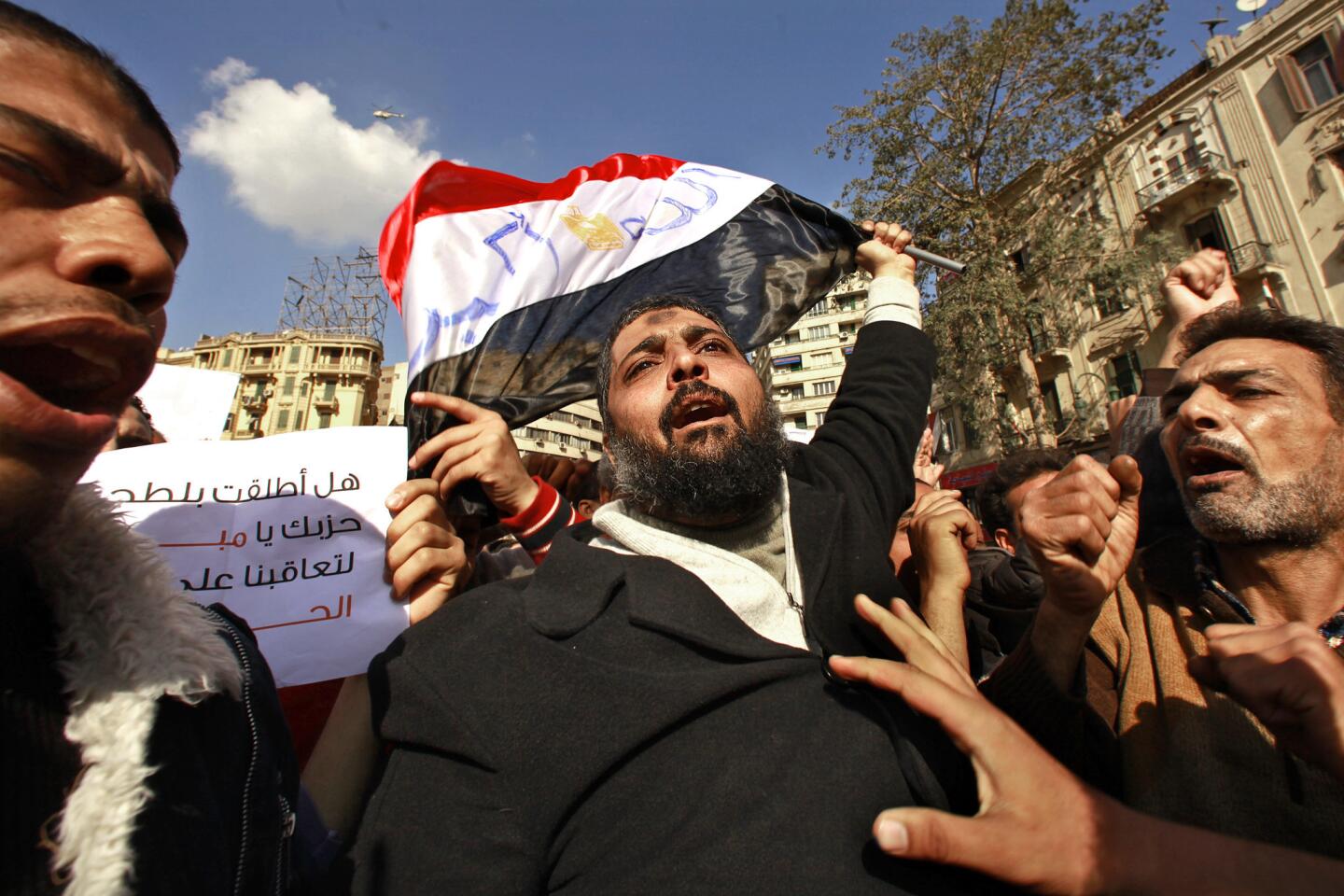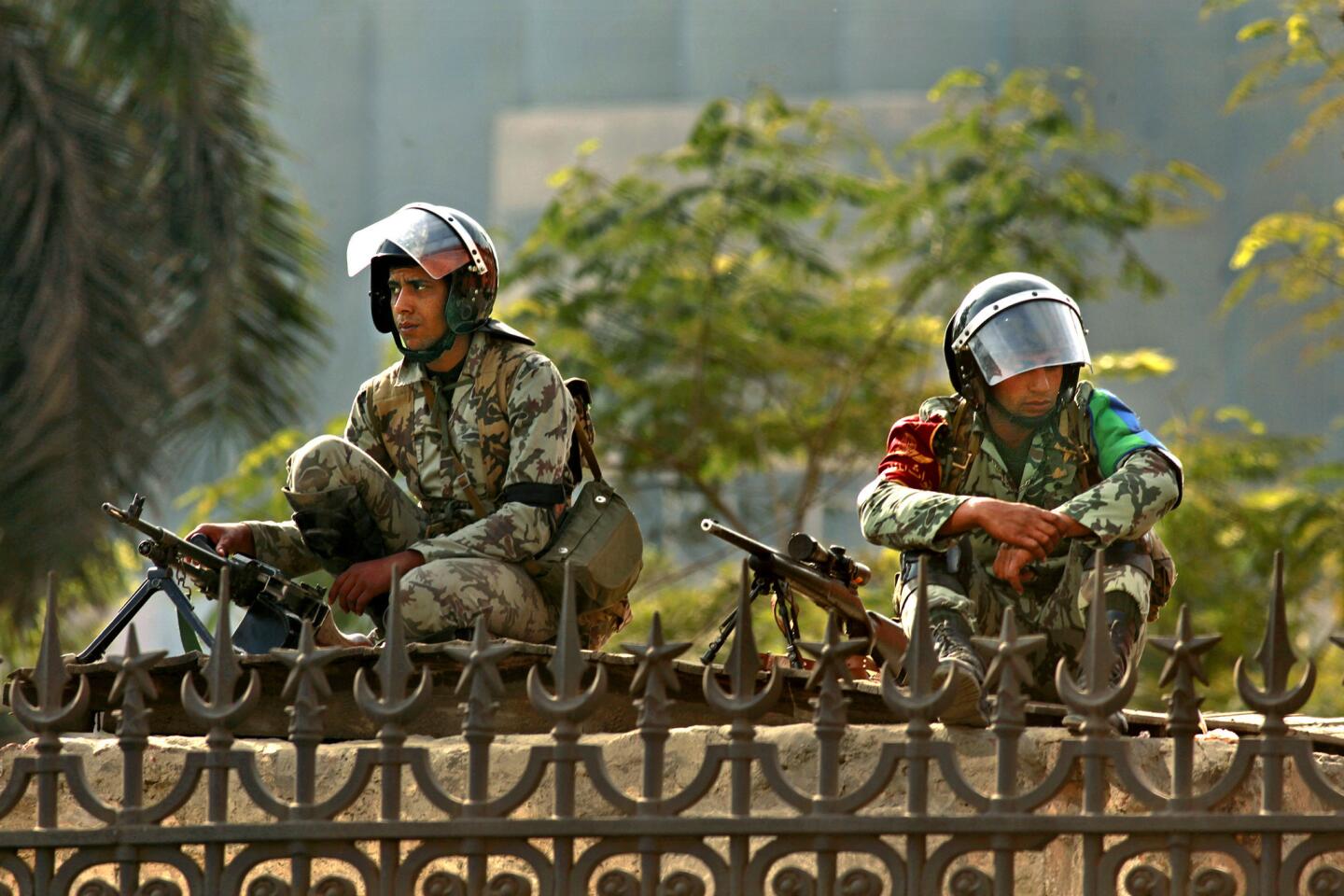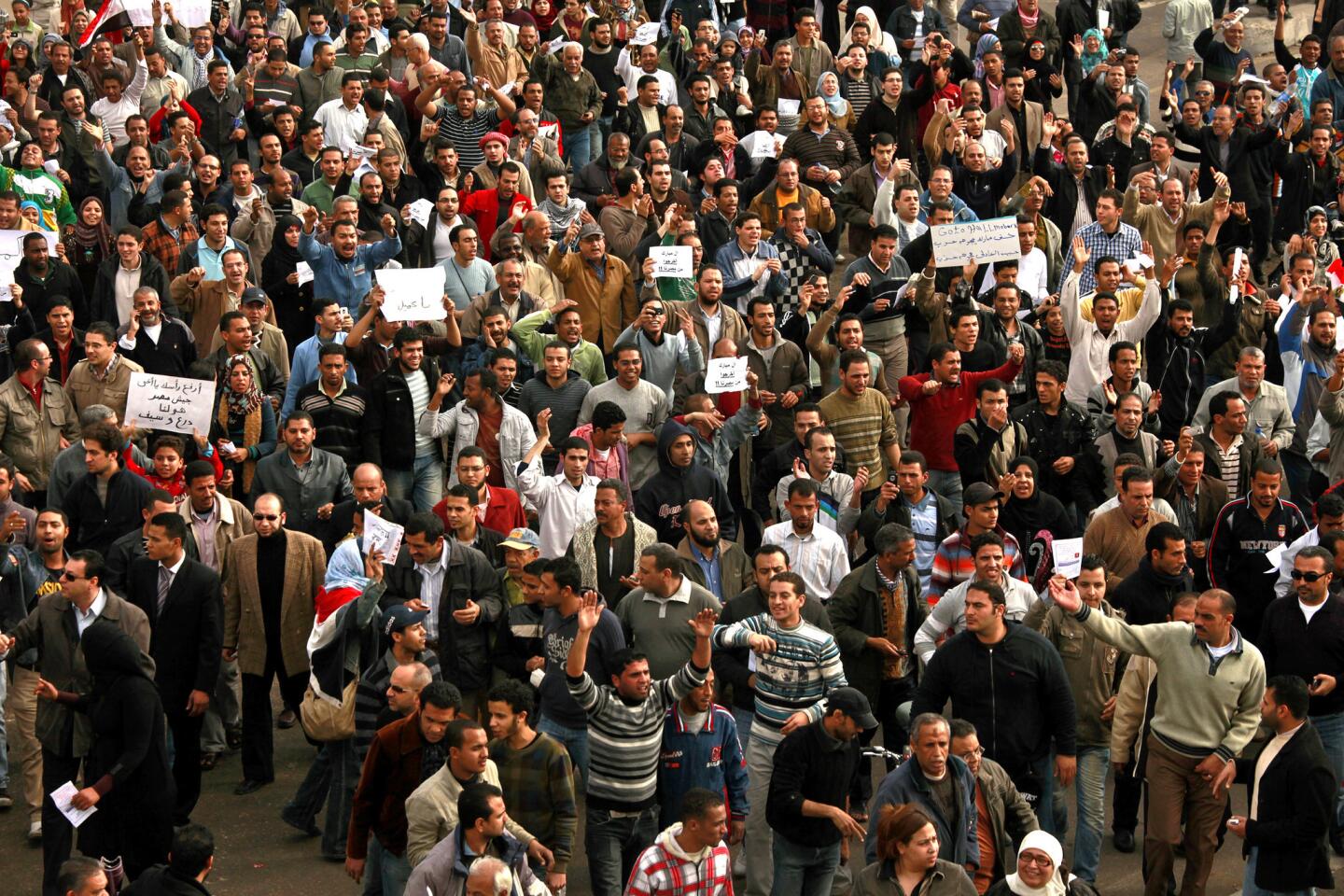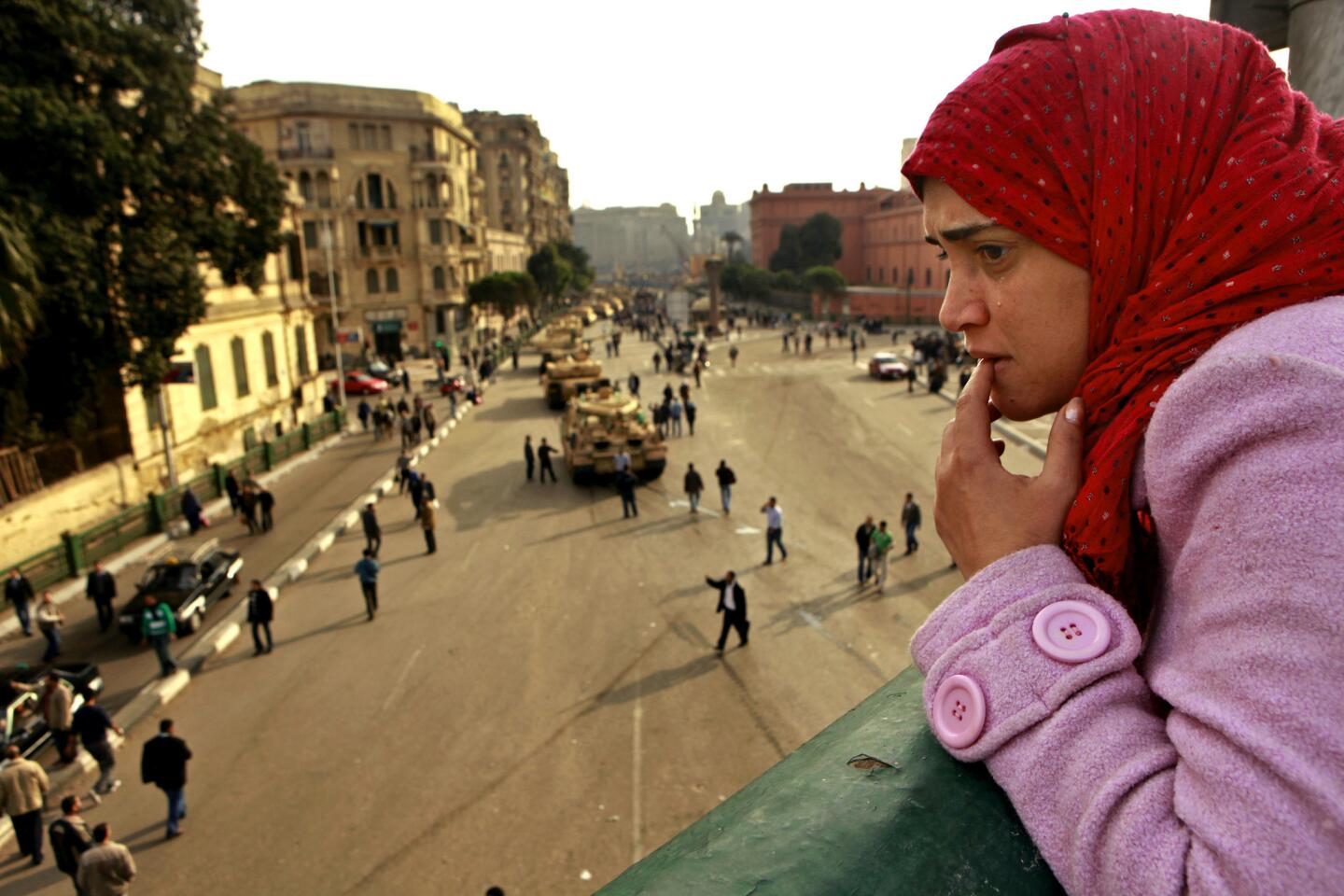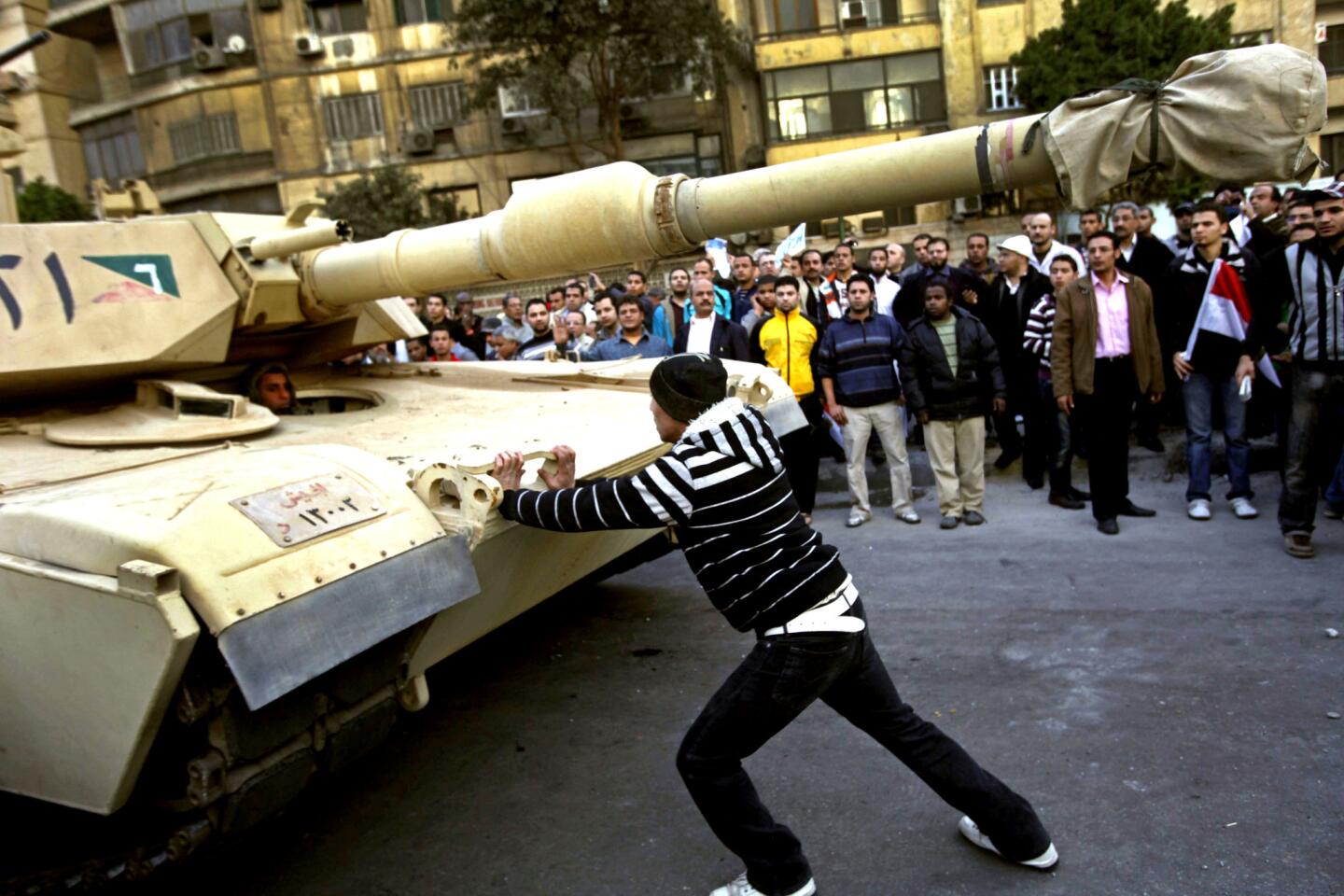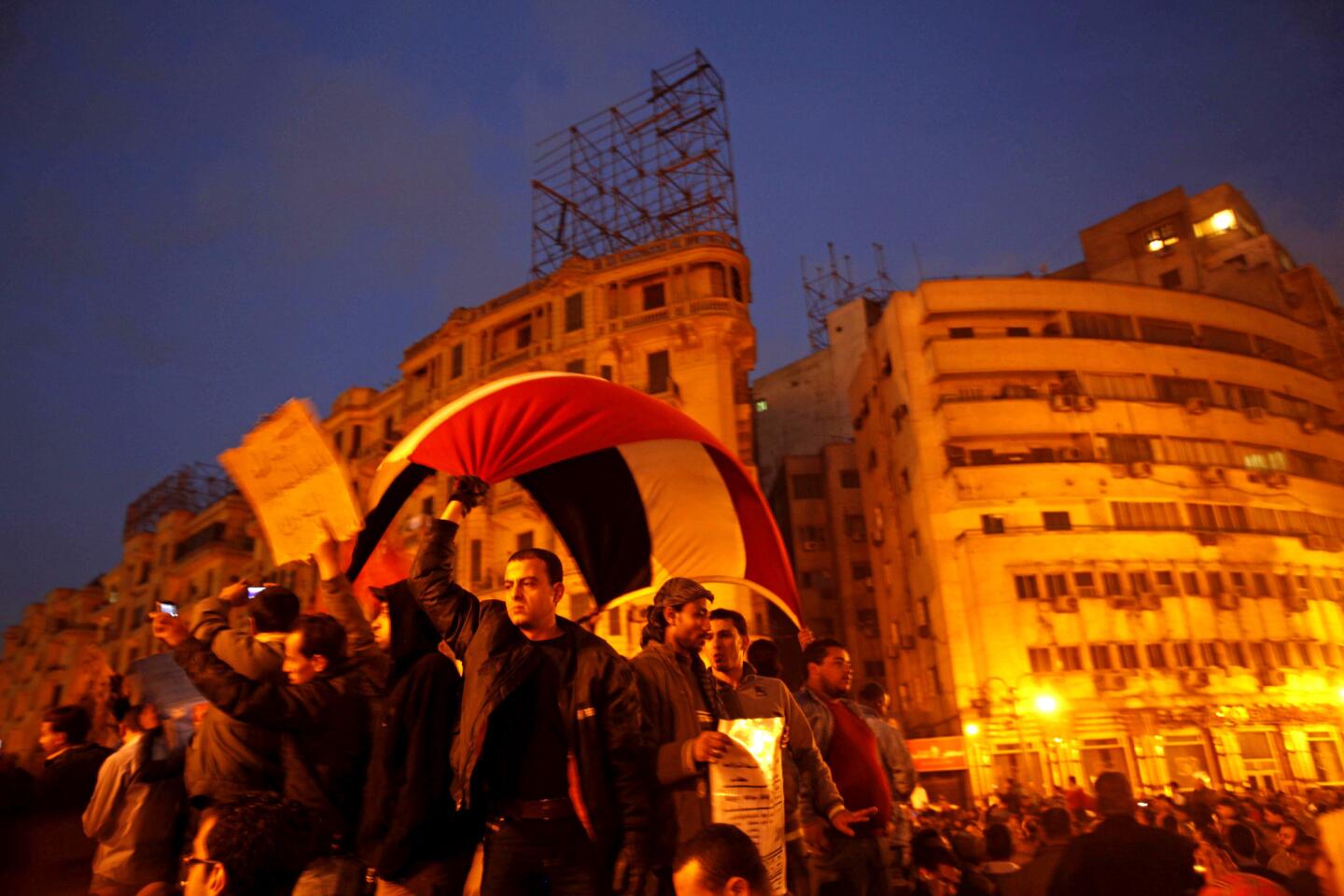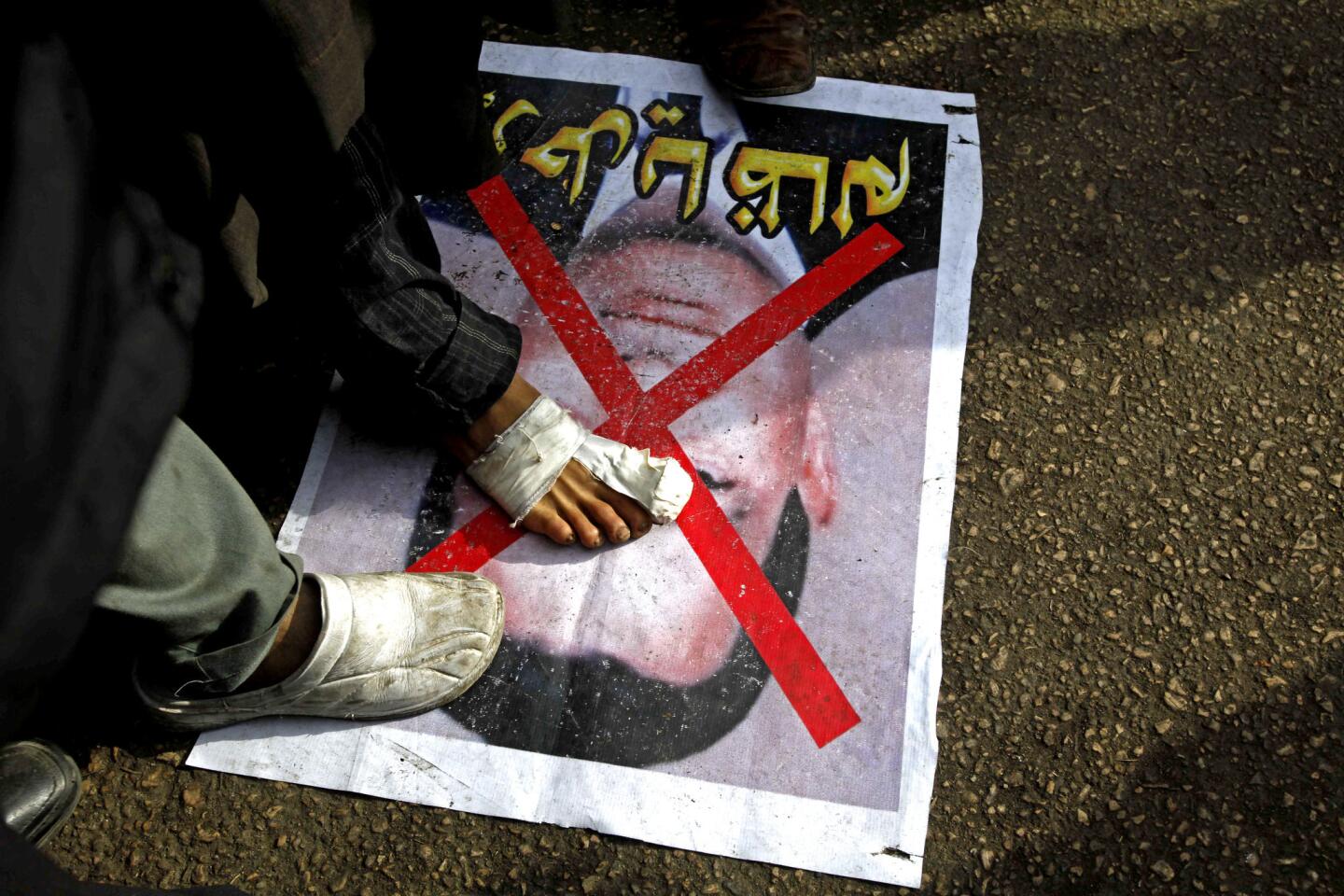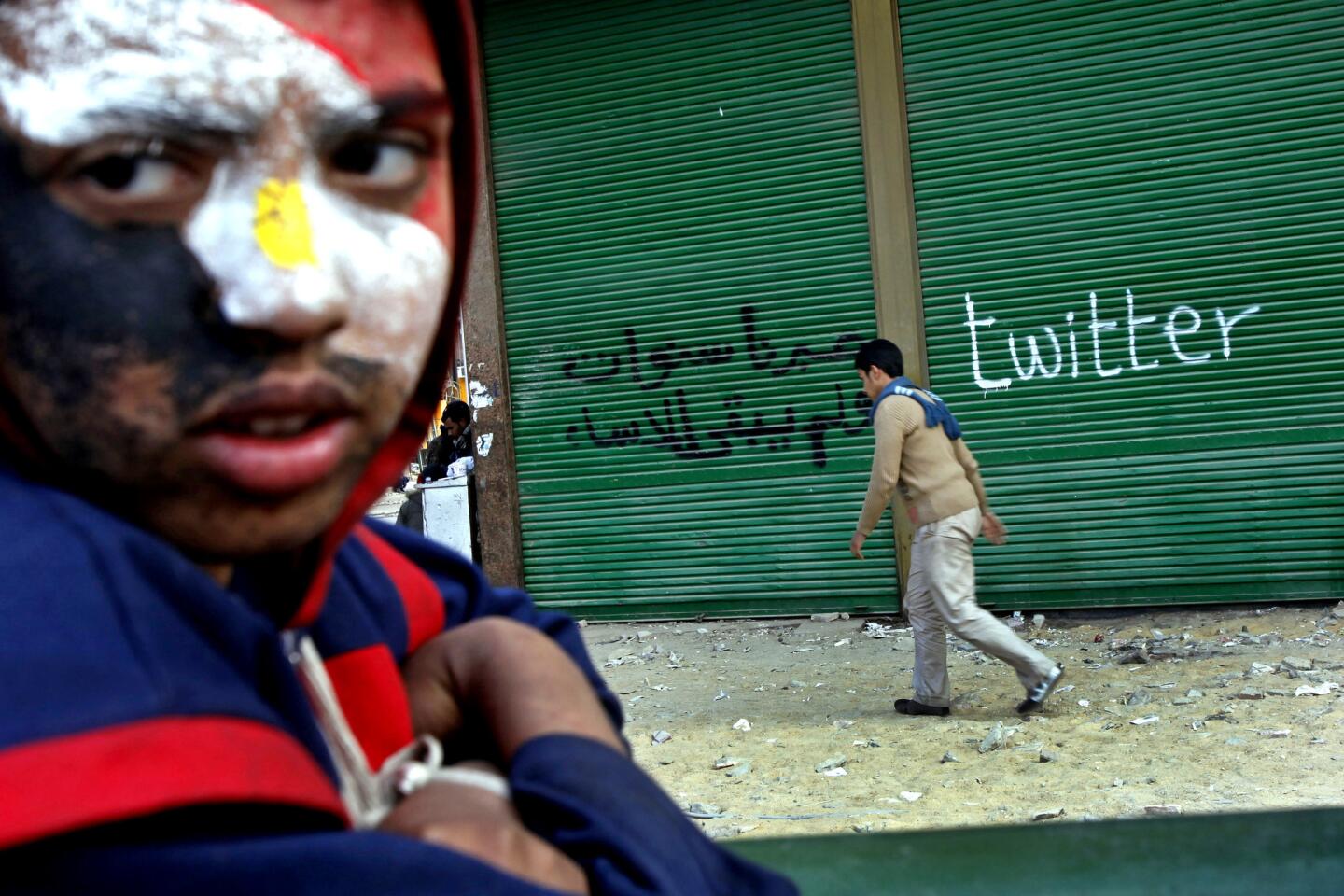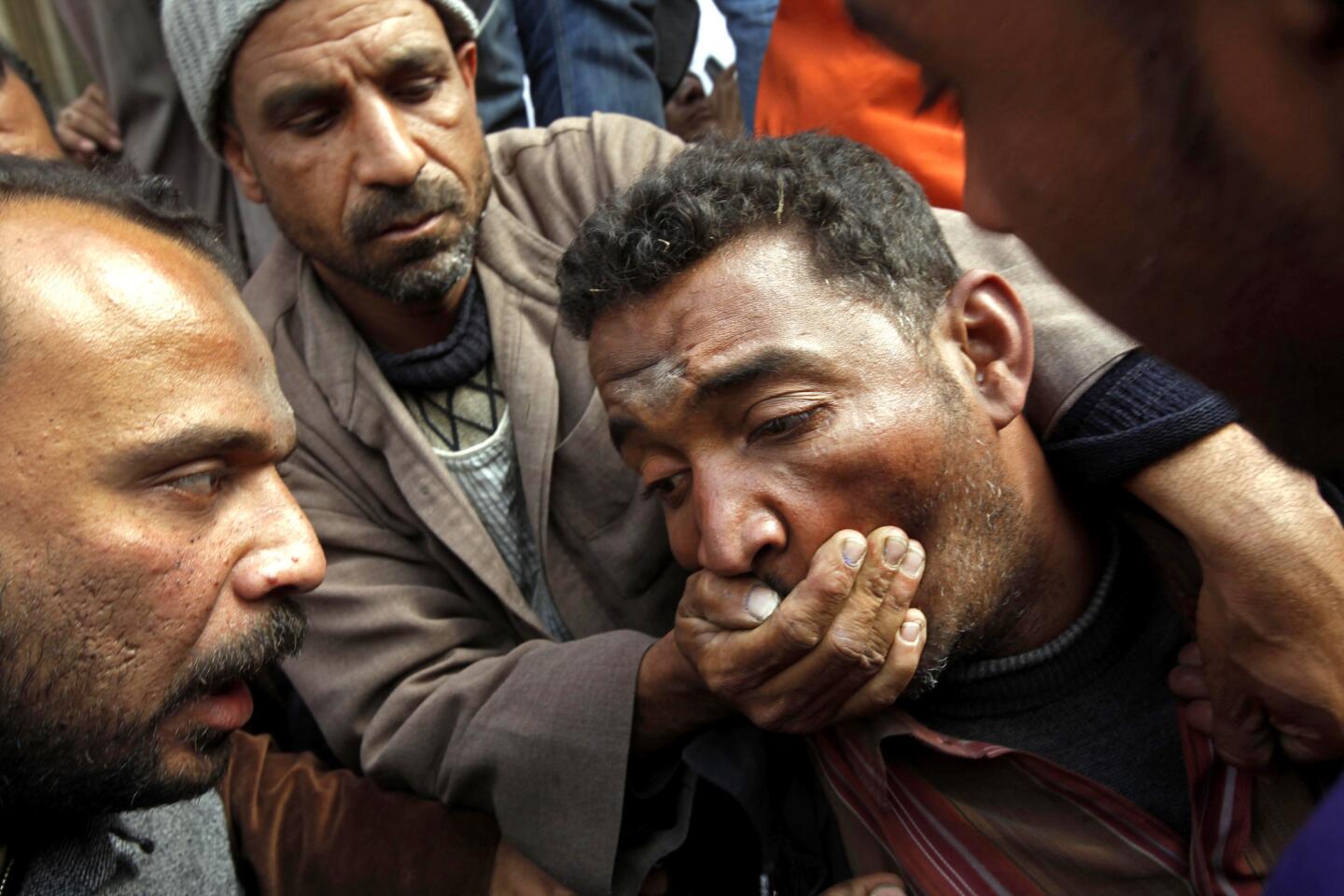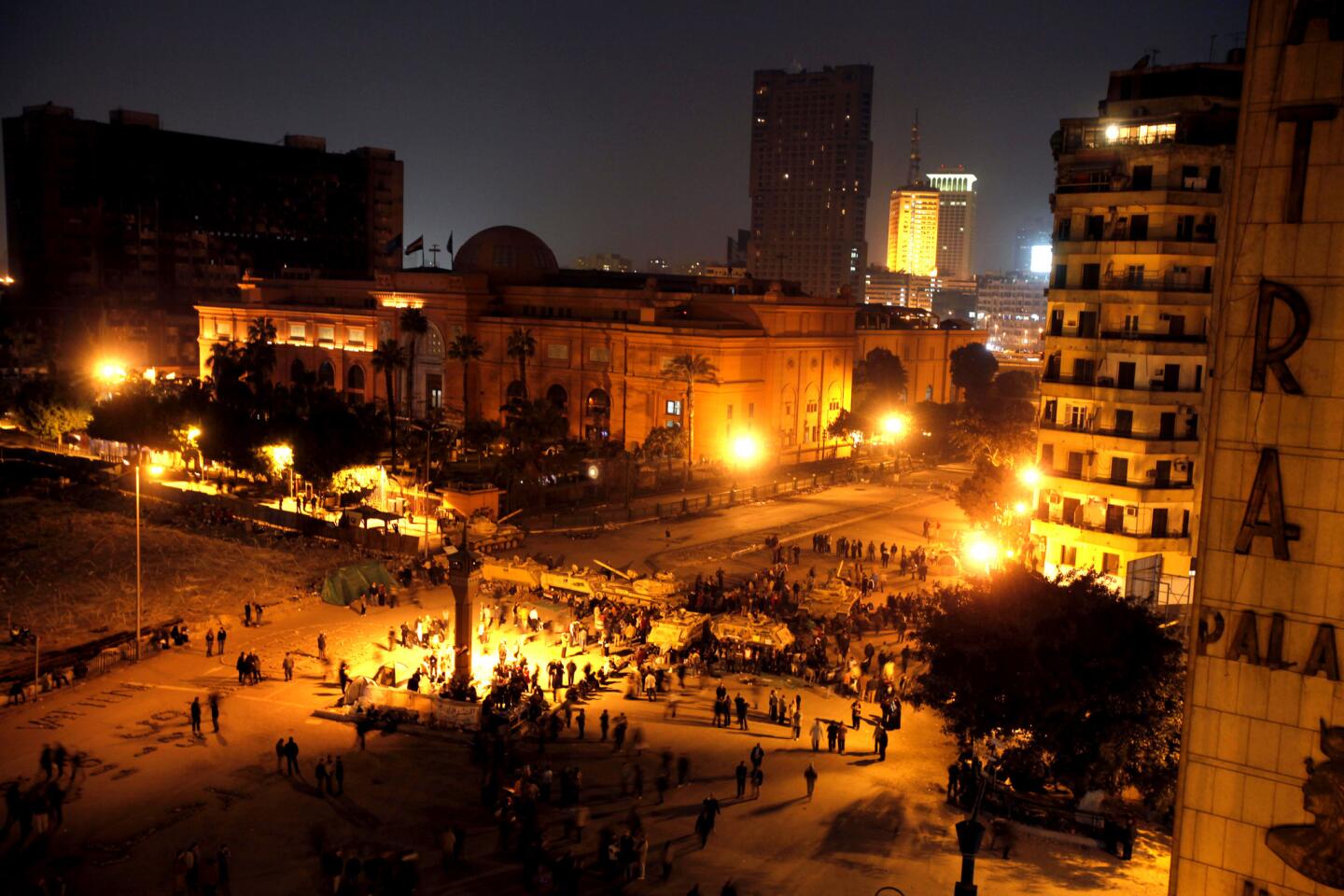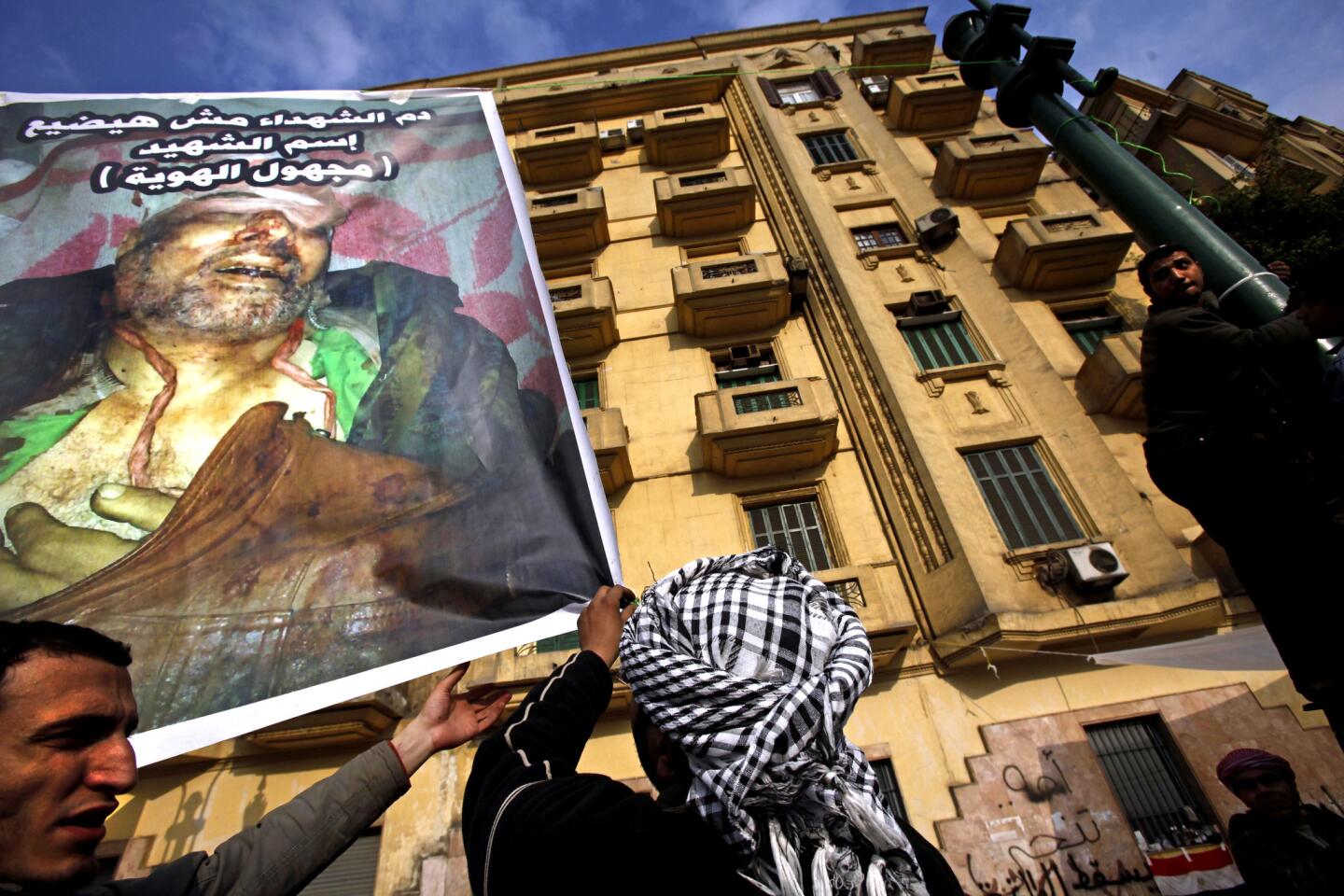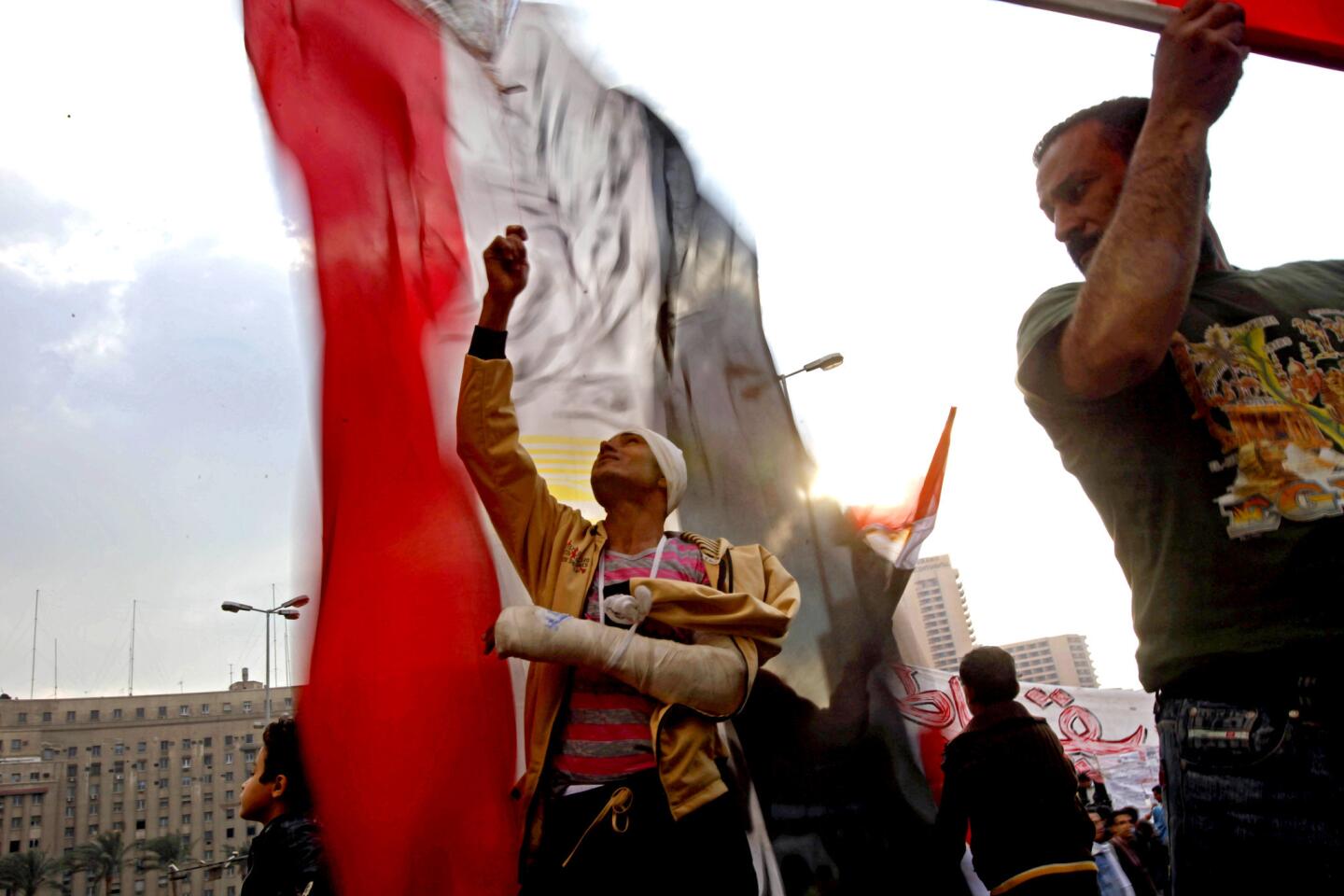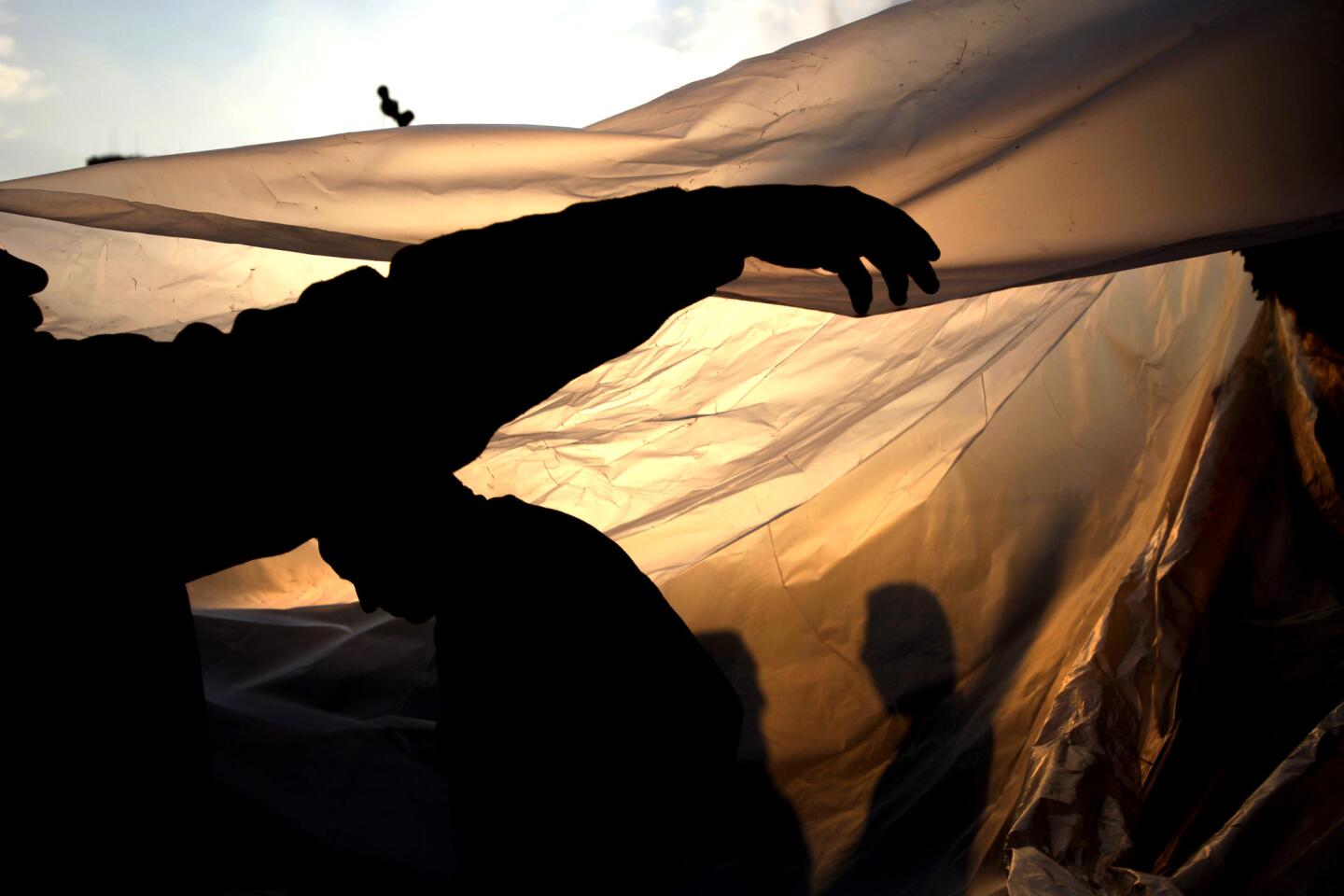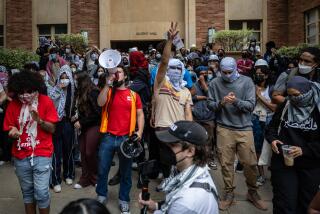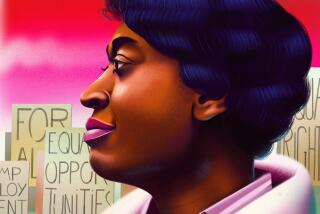Five years on, Tahrir Square activists look back at Egypt’s revolution: ‘Maybe we were naive’
Reporting from Cairo — Five years ago Thursday, Cairo’s Tahrir Square erupted in euphoric celebrations as hundreds of thousands of Egyptians danced, cheered, wept and fell to their knees in prayer on the night that President Hosni Mubarak stepped down after three decades of autocratic rule.
Fireworks lighted the night sky, and songs of freedom filled the air.
The revelers that night, Feb. 11, 2011, included Islamist firebrands and liberal secularists, students and farmers, lawyers and homemakers, many of whom had rarely if ever interacted before. In Tahrir Square, epicenter of an extraordinary 18-day rebellion, they created their own idealized version of society.
But the elated crowds have long since dispersed, their revolutionary slogans replaced with the din of cars in one of Cairo’s busiest traffic circles.
A monument to the hundreds who died at the square was torn down by activists who accused the military-backed government of trying to co-opt the spirit of the revolution. A flagpole flying the national colors has taken its place.
These days people who occupied Tahrir reflect on those heady days and ask: Was the hope for change only a naive dream?
We’re going to Tahrir Square!
— Zyad Elelaimy
Zyad Elelaimy, 35, has been advocating for change since he was a teenager. A leftist lawyer who defends political prisoners, he shed tears when he saw reports of Tunisians celebrating the ouster of their longtime strongman, Zine el Abidine ben Ali, the first leader to topple in what became known as the “Arab Spring.”
Elelaimy doubted Egypt would see an uprising like that in his lifetime. But nine days later, on Jan. 25, he led one of 19 marches across 16 cities to protest repression under Mubarak.
The demonstration began with just a handful of people. But as the marchers made their way from a shantytown on the outskirts of Cairo to the upscale Mohandessin neighborhood, more people joined them.
“The swelling crowds helped us break through one police barrier after the other,” he recalled. Someone asked him what they should do next.
“I spontaneously told him, ‘We’re going to Tahrir Square,’” he said. “It was the widest space that I know of in Cairo.”
Soon, the square was filling with people. But around midnight, police armed with tear gas moved in.
NEWSLETTER: Get the day’s top headlines from Times Editor Davan Maharaj >>
Elelaimy sprinted into downtown, where he collapsed on the ground, overcome by an asthma attack. As police rounded up protesters, a cafe owner came to his rescue, seating Elelaimy and his friends at a table to make them look like ordinary diners.
Three days later, both sides were better organized. Demonstrators converging on the square were initially held back by tear gas, birdshot and water cannon blasts. But as their numbers grew, the police took flight, some officers shedding their uniforms as they ran.
From that day, the square belonged to the revolution.
There is no state at the moment.
— Mohammed Tolba
In Mubarak’s secular Egypt, Mohammed Tolba’s untrimmed beard and the face-covering veil worn by his wife were all it took to arouse the suspicion of the feared State Security.
Although he was not politically active, the 36-year-old software developer and father of three was detained multiple times and questioned about his ultraconservative religious views.
Once, when he tried to drive his family to a Red Sea resort, he was stopped at a checkpoint and ordered to turn back. The officers assumed the family might be terrorists and did not want them near foreign tourists, he said.
In those days, Tolba avoided Tahrir Square because of the Interior Ministry headquarters looming nearby and the plainclothes officers who might swoop in at any time.
That changed the day he was shown cellphone video of a police van driving into the crowd during the first days of the protests. His brother was in that crowd and was knocked over.
Tolba, on a business trip to Sudan, immediately booked a flight home and felt like he had landed in another country. Streets normally full of life were deserted, except for soldiers enforcing an overnight curfew.
The next day he joined his brother on a march to Tahrir. As they got closer, Tolba wanted to turn back. But his brother calmed his fears, telling him, “There is no state at the moment, let alone State Security.”
With each step, Tolba grew more confident. Once inside the square, he was amazed by the diversity of the crowd.
“I was having a conversation with a liberal movie director, something which was completely impossible for me in the past,” he said, laughing at the memory. “I loved the fact that this sort of silence among Egyptian people was breaking.”
We were all together.
— Mohamed Sayed
Mohamed Sayed, a lanky 25-year-old in jeans and a hoodie, works for a tourism agency on Tahrir Square, near Cairo’s world-renowned antiquities museum. He spends his days in the streets trying to tempt foreign visitors with offers on tours. Although the agency was forced to close during the uprising, Sayed sympathized with the protesters.
“Inequality was a cancer entrenched in the Mubarak regime,” he said. Only the well-connected could hope to be treated fairly.
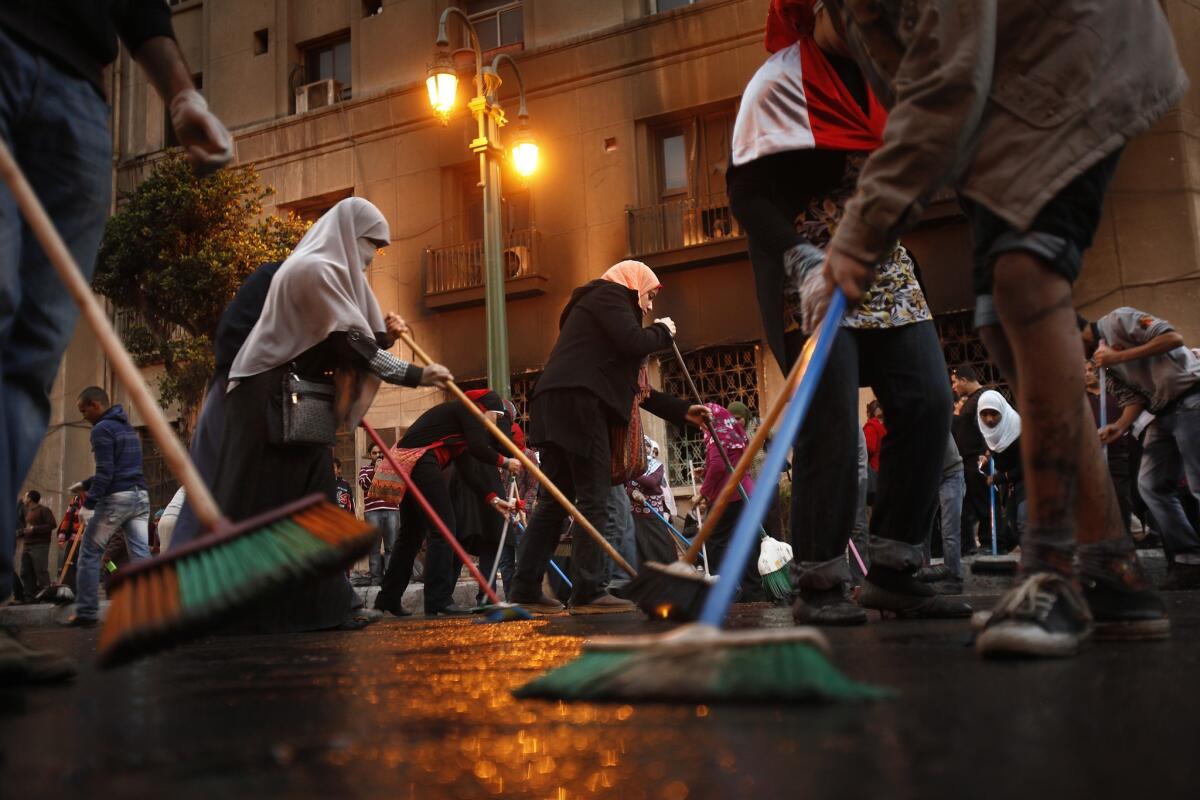
Volunteers sweep the streets around Tahrir Square after an 18-day occupation ended in February 2011.
He watched on TV as hundreds of government supporters, some on camels and horses, charged into the square Feb. 2, wielding clubs and horse whips. The next day, he joined the protesters in the square.
By then, a tent city had sprung up, with teams of volunteers to provide security, distribute food and sweep up trash. There was a medical aid station — and even artistic and cultural events.
“Christian Copts were looking out for Muslims while they prayed. Young people were helping older ones. Guys were helping girls and making sure they were fully protected,” he said. “Before that, you would hardly see 20 or 30 Egyptians standing together in some line without them ending up fighting each other.”
Sayed spent eight days in the square. He was at home the night Mubarak’s resignation speech was broadcast, but ran back to Tahrir.
“We were all together,” he said. “Everybody was singing hysterically. I remember one guy was throwing his toddler in the air and catching him in celebration.”
No one cared who was who.
— Ahmed Hesham
The Muslim Brotherhood, a banned Islamist group that was Egypt’s most potent opposition under Mubarak, did not initially endorse the protests in Tahrir Square. But that made little difference to young followers such as Ahmed Hesham.
Every day, Hesham would arrive in Tahrir around 3 p.m. with his brother and sister, and their mother too, and stay till nearly midnight.
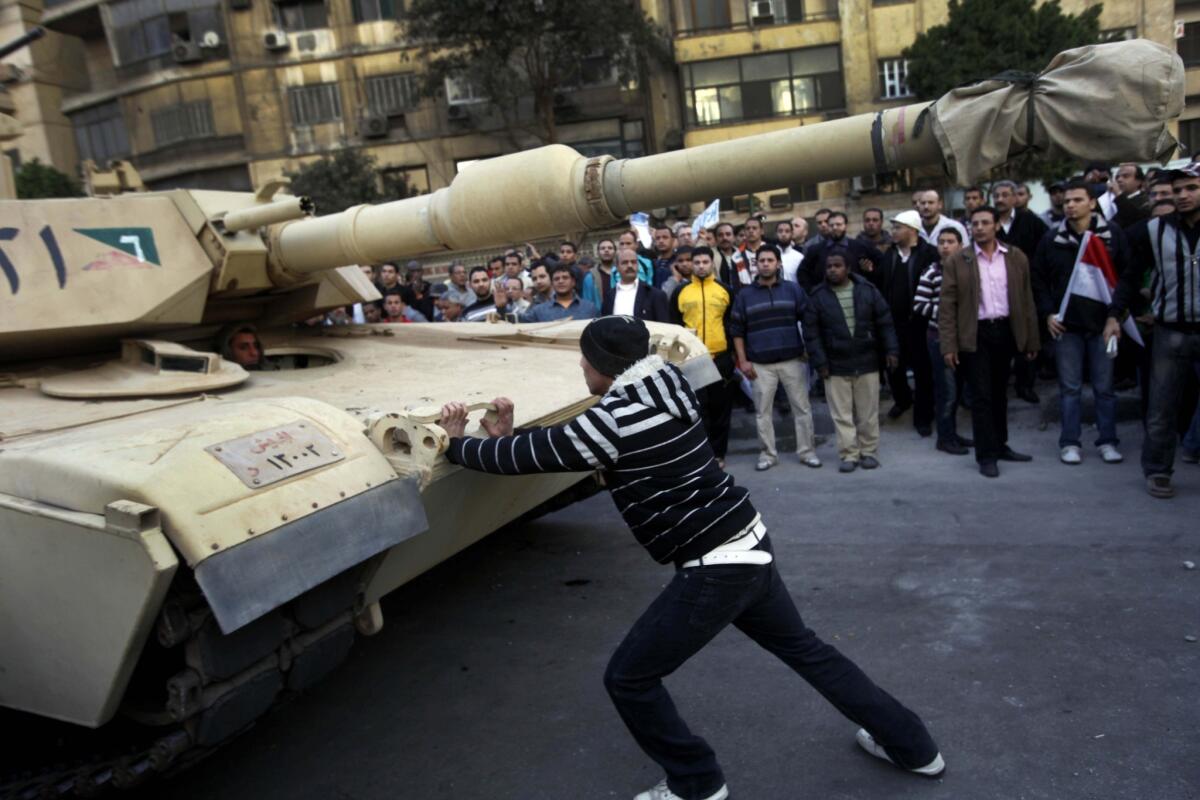
A lone protester steps into the path of an oncoming tank near Tahrir Square in January 2011.
Hesham, now a 33-year-old engineer, remembers how surprised he was by the vast crowd. Until then, he had no idea how many Egyptians believed that Mubarak’s government was unjust and corrupt.
“That was a great feeling, to know that I was not on my own in this,” he said.
Although Brotherhood members established their own spot in the square, that did not prevent Hesham from getting to know the secular activists who called the protests. He spent hours with them discussing their country’s future.
The night Mubarak resigned, he remembers running to his new friends to congratulate them.
“We were all hugging each other in jubilation,” he said. “No one cared who was who or who was with who.”
Something inside me told me that it was not going to last.
— Sara Abdallah
Sara Abdallah, 29, remembers the revulsion she felt the day she saw a police officer beating a thief on her way home from work at a charity near Tahrir. The man begged for mercy, but the officer kept kicking and punching.
The policeman’s brutality is what drew her into the square in 2011, along with the chants of “bread, freedom and social equality.”
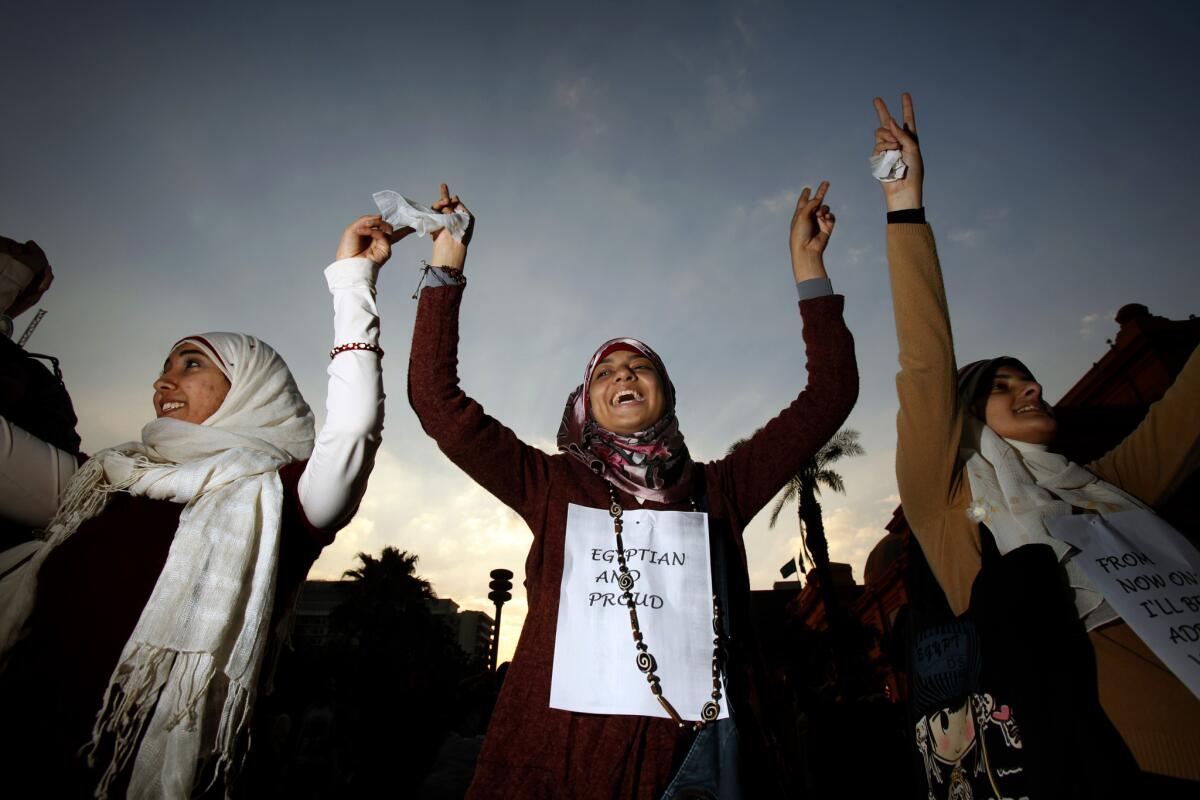
Women celebrate the fall of Egyptian strongman Hosni Mubarak in February 2011.
“As a woman in Cairo, you face harassment every day,” she said. “I have to walk around with my headphones on, so as not to hear some remark that would disturb me — or just use taxis.”
Abdallah, who does not wear a veil, was still living with her parents at the time. It took her days to convince them that it was safe for a young woman to join the protests. But after accompanying her a few times, they too realized that things were different in the square.
“I felt really safe in Tahrir, to be honest,” she said. Still, “something inside me told me that it was not going to last.”
The night Mubarak resigned, a number of women were violently assaulted by mobs of men among the revelers, including the CBS correspondent Lara Logan.
Maybe we were naive.
— Mohamed Sayed
Five years later, Egypt is still beset by poverty, corruption and bureaucratic problems.
The country’s first democratically elected president, Mohamed Morsi, is behind bars along with thousands of his Muslim Brotherhood supporters, and an army man, Field Marshal Abdel Fattah Sisi, is back at the helm of the Arab world’s most populous nation.
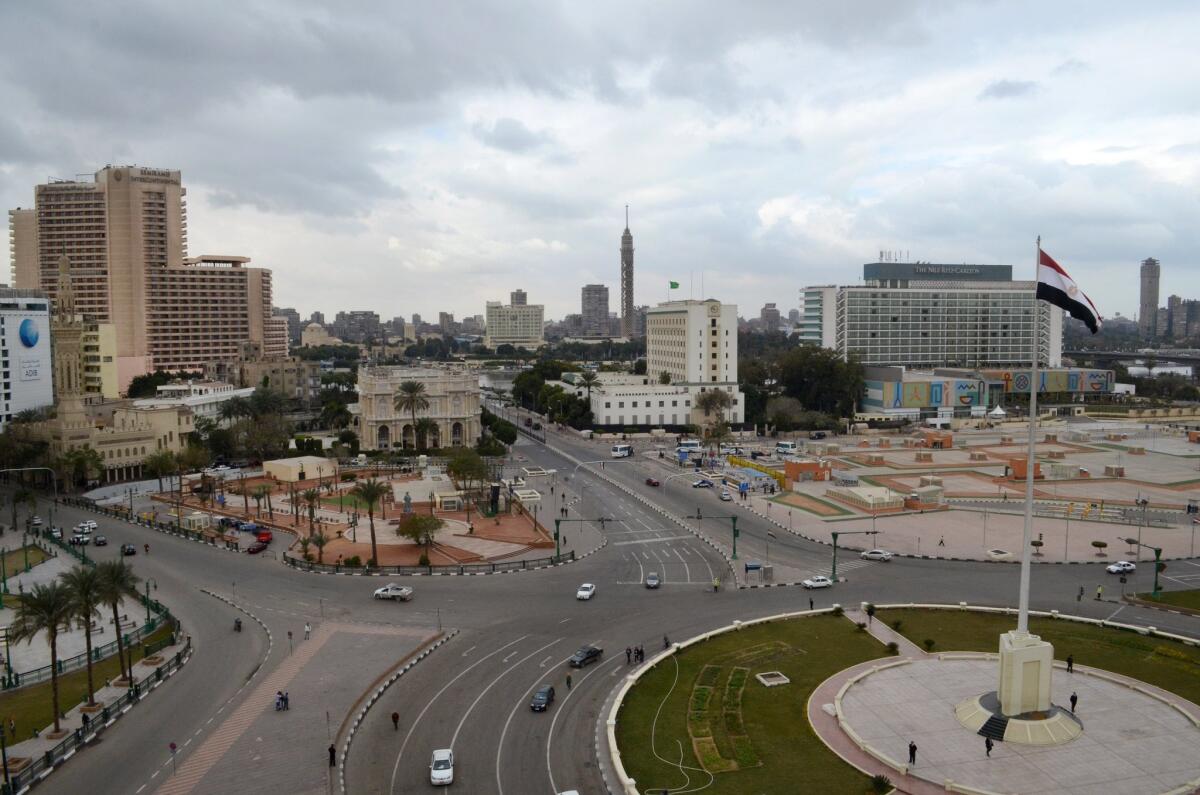
Cairo’s central Tahrir Square, epicenter of an extraordinary 18-day rebellion in 2011, stands mostly empty on Jan. 25, 2016.
Abdallah did not trust the Brotherhood, but she thought Morsi, an Islamist, should have been voted out of office, not removed by the military amid more protests. The deadly crackdown that followed when Morsi’s supporters took to the streets has made her question whether change is even possible in Egypt.
“People were watching a real massacre and cheering for it,” she said.
Some of the people Hesham grew up with were among those killed. One of his uncles hasn’t slept in his own bed for three years, for fear he will be arrested.
Although Hesham faults the Brotherhood’s leaders for believing they could govern without other sectors of Egyptian society, he was stunned by the vitriol directed against the movement on social media. He no longer speaks to some of the friends he made in Tahrir.
These days, even liberal activists are being rounded up. But where some see only defeat, Elelaimy sees an Egypt transformed by those turbulent days in the square.
“The revolution has created a new awareness,” he said. Justice and equality are no longer just terms found in books.
Tolba, too, is convinced that Egyptians will rise up again — if only because the economy is so bad.
See more of our top stories on Facebook >>
But others have grown weary of the perpetual unrest and want to give Sisi a chance to restore order.
“We need any form of stability, otherwise my whole generation’s lives will be lost,” Sayed said.
Attacks by Islamist extremists have increased since Morsi’s ouster, driving away much-needed tourists. Sayed, who relies on commissions at the tourism agency, has seen his income drop by half. He no longer knows what to think about the 2011 uprising.
“We definitely did the right thing, but our lives have only gotten worse,” he said. “Maybe we were naive to believe that democracy can be achieved in 18 days.”
Special correspondent Hassan reported from Cairo and Times staff writer Zavis from Los Angeles.
For more international news, follow @alexzavis on Twitter
ALSO
In war-torn Afghanistan, astronomer sees hope and promise in the study of the heavens
Can U.S. businesses help India’s chaotic cities become ‘smart’?
Syria talks at make-or-break point as humanitarian disaster widens
More to Read
Sign up for Essential California
The most important California stories and recommendations in your inbox every morning.
You may occasionally receive promotional content from the Los Angeles Times.
